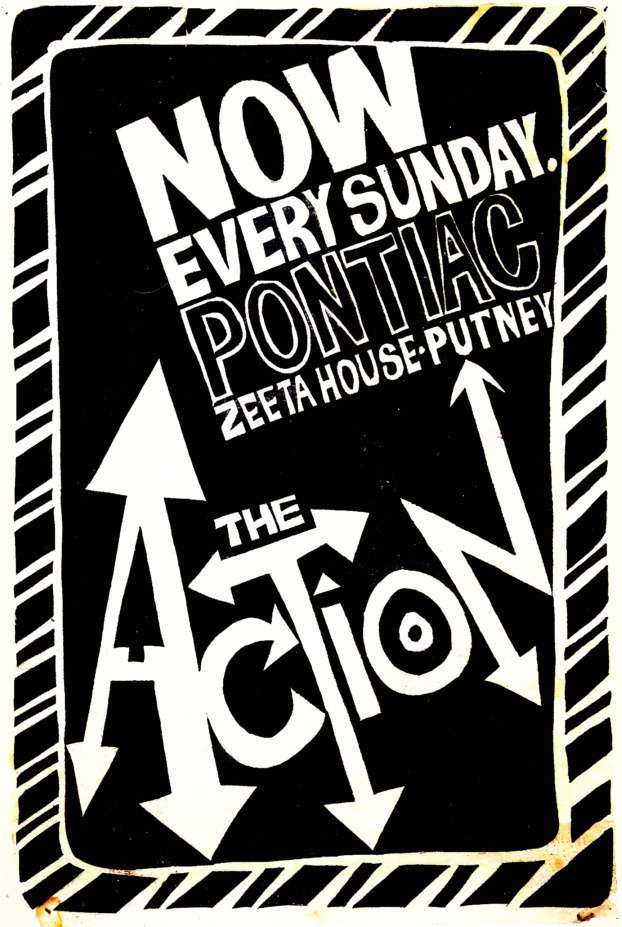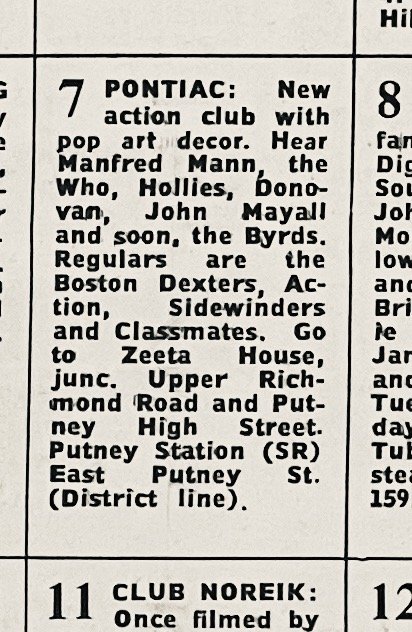‘Pop-art, Op-art and all that similar stuff is beginning to leak out of the avant garde galleries into the field of interior design. The doors open on a beat club in Putney tonight which aims to be the place where all things are happening in the Southern area’.
Charles Greville, Daily Mail (May 27, 1965)
From Ian Hebditch and Jane Shepherd’s essential, The Action: In The Lap Of The Mods (2012). Order [here]
Melody Maker (July 31, 1965)
As much as it was the name that caught my pop-eye – ‘Pontiac Club, Zeeta House, Putney’ – what piqued my interest was the description in Melody Maker’s 1965 cut-out-and-keep guide to London’s beat clubs. It was No.7 on the map: ‘A new action club with pop art décor’. With The Who as one of the named attractions, it was clearly part of the on-going phenomenon of Pop Art into Pop, that ‘leak’ which the Daily Mail’s Charles Greville was referring to when he visited the club on the day of its opening and one then being heavily exploited and led by the ’Bush Boys.
A cursory Google and a quick browse in books you might have thought the club would be discussed in gave up little but a membership card or two, music press adverts and a list of club dates on Garage Hangover [here], which suggests the venue operated for not much more than a year between May 1965 and June 1966.
The club was located in a building designed for the Zeeta Cake Co. that opened in 1938 at the junction of Upper Richmond Road and Putney High Street. There was a smoking room in the basement, the ground floor consisted of shops, a restaurant on the first floor, a ballroom and banqueting hall on the second floor and a bakery and staff offices on the third and fourth. The ballroom had a sprung oak floor with columns propping up a domed ceiling. [For a history of the building see here].
This sequence of images have been copied from RIBA’s webpages
First floor restaurant
Main staircase
The ballroom
Daily Mail (May 27, 1965)
Penny Valentine in Disc listed Johnny and Harvey Riscoe as the club’s owners, but in other accounts Paul Waldman is named as the owner (a June advert in Melody Maker announced the club was ‘now under new management’). The club had been advertising shows at least as early as March 17, but in any event it was Waldman who had invited art students to help redesign the club’s interior. Under the patronage of Sir Hugh Casson, Professor of Interior Design at the Royal College of Art between 1955–75 and director of architecture for the Festival of Britain, students Richard Beal and Alan Saunders were joined by Peter Dale from Kingston College of Art. They painted over the large mirrors that surrounded the dance floor with comic book figures, such as Superman and Iron Man. . . . Donovan was the opening night’s attraction, May 27.
The Kensington News & West London Times (June 4, 1965)
It’s Art Deco interior refashioned for a Pop Art age is a precursor, I think, to Biba’s takeover of Derry and Toms department store in 1973, both buildings were designed by the architect Bernard George (1894–1964)
Biba’s Rainbow Room, where the New York Dolls played in 1973, features a similar domed ceiling design.
Penny Valentine, Disc Weekly (July 3, 1965)
In Disc Weekly, Penny Valentine, described the Pontiac as a ‘sort of pop art club. The walls have been painted by two art students and look like something out of a nightmare with people like Superman in eight foot colour’. Beyond its Pop Art decorations, the appeal of the club was its size, holding over a thousand attendees, it was open Wednesdays through to Sunday, from eight to two in the morning and was unlicensed.
The club instantly became a feature on the city’s gig circuit, offering West London’s premier location after the closing of the Crawdaddy Club at the Richmond Athletic Grounds in July 1965.
Penny Valentine, Disc Weekly (July 24, 1965)
When they played the Pontiac at the end of July, Penny Valentine wondered ‘how many guitars and mikes The Who will demolish tonight’. The band exceeded themselves and even Penny’s expectations, as Andy Neill and Matt Kent note in their chronicle of the band. The Who only managed to play one of their two scheduled sets as they blew out the PA. They did, however, perform ‘My Generation’ for possibly the first time. Though it seems they just missed out on being filmed at the club, acts appearing later in the week ended up playing before cameras even if their efforts were mostly left on the cutting room floor.
Record Mirror (August 21, 1965)
At the start of August, Clarendon Productions spent time at the club shooting scenes for a sequence to be used in one of four thematically linked short films on ‘Romance and Courtship Throughout The World’. Record Mirror listed possible appearances from John Mayall’s Bluesbreakers (featuring Clapton), Graham Bond and, club regulars, The Boston Dexters (The Action would later have the residency). Patti Boyd’s sister, Jenny, played the film’s lead.
The short film eventually appeared in 1966 under the title of Reflections On Love. Approximately three minutes into the eleven minute film ‘the girl’ visits the Pontiac. You can see the double doors, with the star insignia used on the club’s membership card, open onto the ballroom, which is crowded with dancers. The Bluesbreakers are playing but there is no synced audio from the band or anything from arranger Johnny Spence who had been listed as a contributor – the version on YouTube has Kula Shaker delivering the soundtrack. The club sequence has a set of visual effects, colour saturation, that blurs band, dancers and the club’s interior, and is, unfortunately, not much of a rival to Blow Up’s Ricky-Tick recreation, even if the dancers are more animated. It lasts a little less then a minute but some small compensation is that the ballroom’s mirrored walls, columns and ceiling can all be briefly seen.
Though it seems to float freely around on Facebook this is musician Steve Van-Deller’s membership card, he still plays in the Putney area – Google him. He recalls the Bluesbreaker’s gig with Clapton and T-Bone Walker as two standout shows at the venue. In an email to me Steve wrote:
‘I remember being very impressed with the interior, but I was only 15 going on 16 at the time . . .The club had a great vibe . . . The Action were brilliant when they had their Sunday residency, and the Boston Dexters were a great soul covers band too’.
‘We are creating, a modern-day pop image in our own style’, one of the designers told The Kensington News and West London Times, ‘We made pop art into an interior, instead of leaving it on a white canvas’. Peter Dale added that he would be ‘rather pleased if people don’t like it’.



















